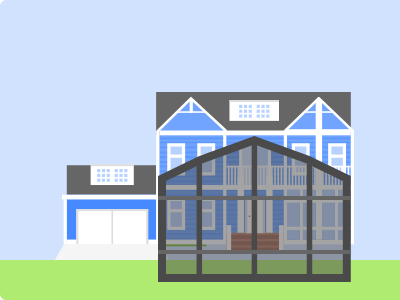
Sunrooms
Generally speaking sunrooms are usually added on after the house's initial construction. New sunroom additions are built with the intent of getting as much sunlight as possible, and are therefore built on the side of the home that sees the most sun. Otherwise the ultimate function, whether that be for gardening, relaxing, or just soaking up the rays, is ultimately up to the homeowner. In any case, a sunroom can make a great addition to any household. While installing a sunroom for your home can cost anywhere from $10,000 to $80,000, most homes on average spent about $15,100 for their sunroom (2). Sunroom features typically include (3):
-

-

Large, open windows
-
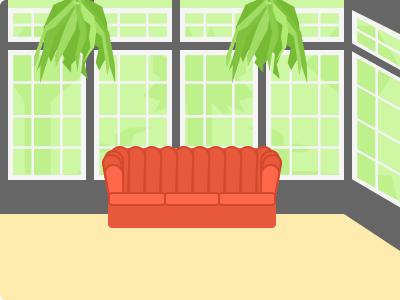
Gardening options
-
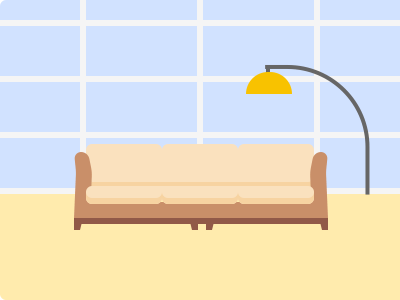
Comfortable patio furniture
-
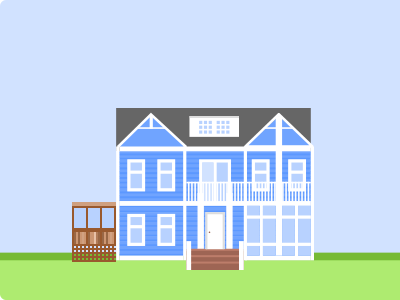
Often a deck-style construction
Solarium
The term "solarium" can technically be interchangeable with sunroom. By definition, a solarium is any room outfitted with an extensive amount of glass to allow as much sunlight in as possible. Alternatively, it can also mean a room retrofitted with heating lamps or tanning beds. Whichever the case, it's a room that will boost your intake of vitamin D as well as your curb appeal (4). Regionally names for sunrooms can differ, and some other designations for sunroom include:
- • Sun parlor
- • Winter garden
- • Sun porch
- • Patio room
- • Florida room
- • Garden conservatory
- • Conservatory
- • Interior patio
- • Portico
- • Porch
Different Styles
There are so many different styles for sunrooms that it really depends on the homeowner's personal tastes and how those preferences compliment the house. Are you going for a formal affair? Or are you trying to grow your garden practically? Perhaps some avant-garde architecture for the modern age? Whatever the design, a sunroom can easily be constructed in accordance with the homeowner's wishes. Amazing interiors, custom lighting, and panoramic views are all things that can be easily incorporated in a sunroom construction (5). You can easily focus the architecture towards either a more interior or exterior design. Best of all, there are even pre-built structures that can easily (and affordably) be delivered and tacked on to your home (6). Pre-built units can cost around:
- • Small: $11,170 + $700 shipping
- • Medium: $14,111 + $825 shipping
- • Large: $19,275. + $950 shipping
Living Room Design
Providing elegance and luxury are paramount when promoting curb appeal for any home (7). For a fancy home addition that truly boosts the value of your home, go for a more interior-focused approach to your sunroom. Essentially a living room that gets a great amount of sunlight, this is the perfect location for relaxing and reading a book. And it's certainly a great place to keep a small library for yourself. In any case, there are many designs that allow you to enjoy the natural sunlight (8).
Back to topIndoor Patios
Some homeowners prefer a three season approach to their sunroom. Essentially this acts as an indoor patio for your house (9). You can easily make this addition feel more roomy with the addition of French doors to really open up the space. Feel free to add new and dynamic lighting to get the most out of the room. For a truly relaxing outdoor environment, but indoors, try a patio-style sunroom.
Back to topLittle Greenhouses
It helps to think of your sunroom as a sun-space that has different purposes depending on whichever season it is. Essentially, this means that three seasons a year your sunroom can act as a greenhouse (10). If you can, be sure that your sunroom is pointed as close to true south as possible, so that it's getting the best sunlight on all sides. This acts as sort of a passive solar energy boost that will make your indoor plants grow better and save you money on heating bills. When it comes to the glass windows, dual glazed seems to work the best in terms of moderating temperature (11). This is true for all but the most temperate of climates.
Back to topPassive Solar Building
As mentioned above, sunrooms that face as close to true south as possible can actually use the solar energy gained from that positioning to naturally heat your home (12). Additionally, sunroom technology has come a long way since they began to grow in popularity in the 1960's (13). Now we have specially engineered aluminum siding, special panes for glass windows, and intricately detailed roof shingles to maximize the amount of light and heat you gain from the sun. This in turn passes the energy saving to you. You can save money by incorporating any of the following to your sunroom:
- • Sunroom engineered roof panels - $35 per sq. ft.
- • Insulated ceiling sheets - $112 per sheet
- • Double pane glass windows - $134 each
- • Full aluminum greenhouse paneling - $1,100 total install
Energy Efficiency
While the sunroom not only lowers your heating bills, it also effectively lowers your cooling bills when properly insulated. On top of that, the electricity costs for that room are also negligible (14). Who needs to turn on the light when you have natural sunlight filling the space? And if your sunroom is facing true south that means that you're earning the full 90% maximum potential for solar energy that your room can receive. If you've installed new windows for your sun room, it's reported that you can save between 26% and 52% of your total energy bills with this home addition (15). While that may not pay for the total cost of installation, it comes close over the years and will certainly factor in if you're looking to sell (16).
Back to topReferences
- "Sunroom". Wikipedia. Retrieved 31 August 2017.
- "Cost Vs. Value for a Remodeling a Sunroom". SFgate. Retrieved 31 August 2017.
- "Sunroom Comparison". Patio Enclosures. Retrieved 31 August 2017.
- Chandrasena, Amali. "Dying for a Tan". NCBI. Retrieved 31 August 2017.
- "12 Sunrooms That Are Bright and Welcoming". Architectural Digest. Retrieved 31 August 2017.
- Wallender, Lee."Sunroom Additions: Better Than Conventional Stick-Built Additions?". The Spruce. Retrieved 31 August 2017.
- "11 Elements of the Perfect Sunroom". houzz. Retrieved 31 August 2017.
- Tucci, Amanda."28 Spaces That Prove Natural Light Is A Room's Best Friend". House & Home. Retrieved 31 August 2017.
- Blanchard, Jane."7 Great Sunroom Ideas". modernize. Retrieved 31 August 2017.
- Wright, David. "Plan the Perfect Sunroom Addition".
- Lee, David."Build an attached solar greenhouse". Backwoods Home. Retrieved 31 August 2017.
- Lea, Kela. "Passive Solar Sun Room". Green Passive Solar. Retrieved 31 August 2017.
- Partridge, Alan."Sunroom Technologies". summerhouse24. Retrieved 31 August 2017.
- "Sunrooms and Sunspaces". Energy.gov. Retrieved 31 August 2017.
- "Energy Efficient Tips for Adding a Sunroom to Your Home". RESNET. Retrieved 31 August 2017.
- Lee, Jenica."How Much Can Replacement Windows Save On My Energy Costs?". Southwest Exteriors. Retrieved 31 August 2017.
Select your Sunroom project
Service Cost Calculator
Enter service and
zip code to view
cost breakdown
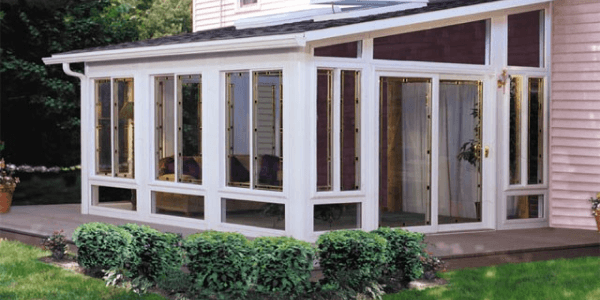





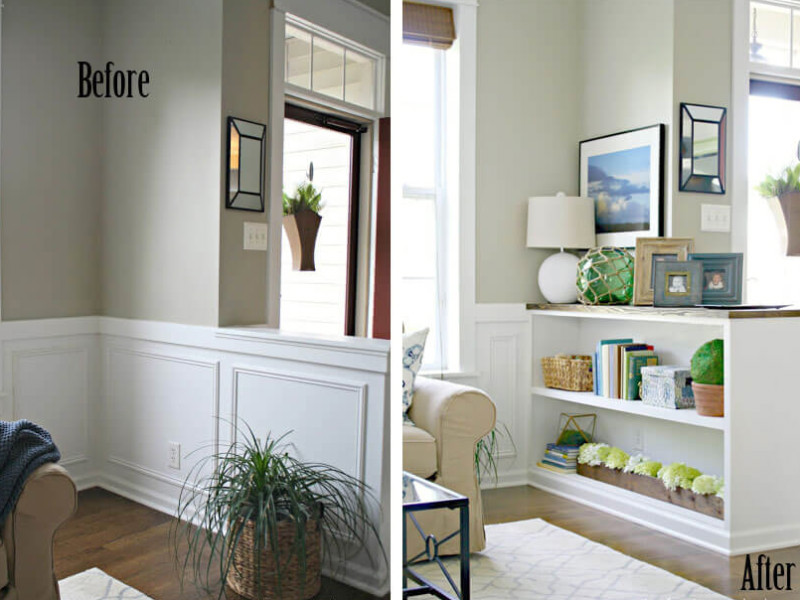














![Summer Home Maintenance Checklist [2024]](https://images.homeyou.com/website/base/f75/ce7/35a/1080-591-summer-maintenance-checklist-for-homes.jpg)
